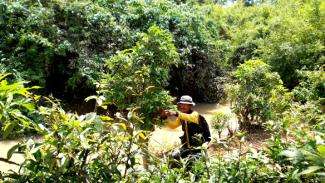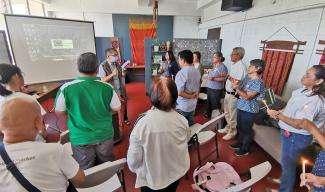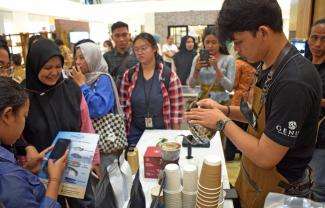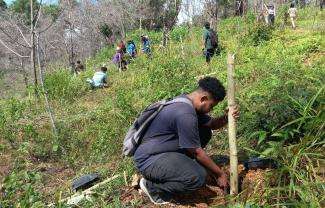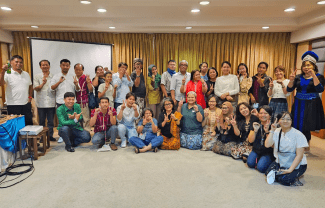The Yayasan Konservasi Way Seputih (YKWS) has been working in Lampung for 7 years. The big achievements of this NGO (Non Government Organisation) are assisting the community in the Kota Batu Village, Pubian Sub-district, and participating in the formation of the Giri Mukti Wana Tirta Community Logging Cooperative (Comlog GMWT) that is active in the development of the Community Forest in the Central Lampung Regency.
Several other institutions participate and support the existence of a community-based wood trade through various aspects. Telapak introduced the concept of the Negotiated Approach toward an Integrated Water Resource Management (IWRM) which was later used to choose the location of the EA-Samdhana Project. The Partnership Institution and the NGO LATIN work together on projects in the formulation of the Project Design Document to obtain a certification on carbon trade. While the Samdhana and Ecosystem Alliance expressed their support by replicating the management of community forest in Air Naningan, Central Lampung and Buana Sakti East Lampung.
The concept of the Negotiated Approach towards an Integrated Water Resource Management (IWRM NA) and the application of the River Basin Areas approach are the bases in the development of the several work programs of NGO YKWS in Kota Batu Village, Pubian Sub-district, Central Lampung. The operations of GMWT Cooperative is located in the Way Seputih upstream river basin, Air Naningan Sub-district, Central Lampung where the location of the replication will be implemented in Way Sekampung upstream river basin. Both are the water catchment areas of the Batutegi Dam which is the source of irrigation of the Metro rice granary area, East Lampung. In the downstream part, assistance is provided to the community in Batanghari Village, Buanasakti Sub-district, East Lampung wherein the aspect of the management of Community Forest was tried on honey and the aspect of Non Timber Forest Products.
Brief Quote from a Farmer in Tanggamus and East Lampung
Mr. Sutrisno - Critical Land in Air Kubang Village, Tanggamus Regency
"If you want to obtain a water source, plant the bald lands with greens," the father stated to Mr. Sutrisno.
The available land that was only covered with grass is now shaded with various hardwood plants (jeunjing, akasia, jati, sonokeling). Those provide shade for the coffee plantation in the lower part. Water springs, which in the local language are referred to as ‘sumber,' emerge in several places. It is from this source that the community of Air Kubang Village, Tanggamus Regency, Central Lampung obtain their clean water.
Mrs. Cici - Women and Agriculture in Air Naningan Village, Tanggamus Regency
Women are always considered as not capable of becoming farmers. Usually, they are only in the kitchen. I can prove that I can produce various agricultural products like jeunjing timber, coffee, candlenut, and pepper. Thanks to the hard work of the Tirto Kencono Farmer's Group, Tanggamus Coffee at present is already included in several big coffee factories. Now, I'm learning to spawn freshwater fish and cultivate honey for Mr. Pur in the neighbouring village.
Mrs. Cici is the Chairperson of the Tirto Kencono Farmer's Group. Her father bequeathed several partitions of lands for the existence of a potential preliminary cooperative institution that develops the system of savings and loan among the 35 members of the TirtoKencono Farmers' Group.
Mr. Purwadi - Forest is Honey, Buana Sakti Village, East Lampung Regency
YKWS came and promulgated the management of wood in the six villages in the Batanghari Sub-district in 2012. Serkel (a wood saw machine that is installed in a vehicle) is already available for the community that will process nyerut (cut wood to turn it into a board with specified measurements).
However, for me, and for my farmers' group, that cultivates honey, forest is honey. We are promoting the village honey movement in community forests. What we want is a forest education wherein the timber is not cut but to make honey its production. Capital and people who have a special skill are necessary to make this happen.
Mr. Purwadi is the Chairperson of the Farmers' Group that Cultivates Honey in Dusun 4 Sidomukti, Buanasakti Village, Batanghari Sub-district, East Lampung. In 2009, he attended a forest honey bee training provided by the Ministry of Forestry Regional Office. Since then, he tried to develop a forest honey business in the 26 hectares of secondary forest area owned by the farmer group that is mostly planted with Tangkil and Sonokeling trees. Mr. Pur obtains many invitations to several training and has become a knowledgeable and resourceful person regarding the cultivation of forest honey. In his backyard, there are various types of bee species in cages.
Giri Mukti Wana Tirta Comunity Logging Cooperative (Comlog GMWT)
The Community Logging Movement and the formation of the community group cooperative is an effort to maintain the sustainability of the livelihood of the community through the management of the community forest. The Members of the Comlog GMWT Cooperative are the owners of the community forest in Central Lampung Regency. This institution was established in March 2011 in Pekandangan Village, Pubian Sub-district, Central Lampung Regency.
The cooperative was started in 2009 and was named Wana Tirta Cooperative. The name was later changed to Giri Mukti Wana Tirta Community Logging Cooperative and obtained Legal Body Number : 28/BH/PAD/X.2/2011 on January 2011.
Illegal logging and forest land clearing in the Protected Forest Area Register 39 Kota Agung Utara Wilayah, Pubian Sub-district, Central Lampung is rampant. If these activities occur, potential consequences include: 1) the discharge of the Way Seputih River decreases (dryness); Â 2) landslides and flash floods occur in several villages in upstream areas; 3) the results of the production of agricultural plantation decreases; 4) the level of unemployment increases as a consequence of the closure of wood industries; and 5) it is difficult for the residents to obtain clean water.
The objectives of the formation of the Comlog GMWT Cooperative are: 1) to enhance the well-being and standard of living of the members in particular and the community in general; 2) to start a movement in re-establishing an economic order in the village; and 3) to create sustainable forest management through the institutionalization of a cooperative.
The following is the scope of the work area and membership of the Comlog GMWT Cooperative in the Pubian Sub-district: Kampung Pekandangan Community Forest, Kampung Tawang Negeri Community Forest, Kampung Kota Batu Community Forest, Kampung Payung Dadi Community Forest, Kampung Payung Makmur Community Forest, Kampung Gedung Aji Community Forest, Kampung TerbanggiIlir, Bandar Mataram Community Forest and Kampung Rawa Betik Community Forest
The business products of the Comlog GMWT Cooperative are composed of: a) Wood products: sengon, jati, akasia, mahoni, and cempaka. b) Non-wood products: pepper, coffee, spices, natural honey, and c) Development of bio gas energy service. At present, the products that are actively produced are wood products while there are several pilot projects for bio gas. They are still searching for a market for Non Timber Forest Products.
The guarantee for the availability of raw wood material at the local level should be supported by a clear document so that it would not bring about forest degradation and illegal logging in the said area. The government issued the Regulation of the Minister of Forestry No.P.38/Menhut-II/2009 concerning the Standard and Guideline in the Assessment of Sustainable Forest Management and Timber Legality Verification to the Permit Holder or Private Forests and Timber Processing Industry. This momentum was utilized by the Comlog GMWT Cooperative to obtain recognition from the Ministry of Forestry.
In November 2011, the Comlog GMWT Cooperative obtained a Certification on the Legality of Wood Standard Verification (SVLK) from the Directorate General of Production Enterprises of the Ministry of Forestry. This document is in response to the market demand on raw wood material by ensuring that the unit management or industry is already using legal raw materials that are proven and protected by a legal document.
In the first certification on 11 January 2011, Certification VLK No. 00050 was published for the 22.5 hectares of Community Forest with 103 members. In January 2013, the Comlog GMWT Cooperative extended the Community Forest, reaching a count of 233 members.
The development activities conducted by the Comlog GMWT Cooperative in Central Lampung are Processing of Forest Wood Products in the form of logs and furniture, Wood seedling , Development of bio gas energy as a local initiative of the adaptation process on climate change, Development of Non-Wood Forest Produce in the form of honey and spices, Development of environment service through the adoption of trees in the effort to reduce carbon emission.
The Potential of Tanggamus (Central Lampung) and Buana Sakti (East Lampung)
M. Sidik, Director of NGO YKWS stated that the replication of the Comlog GMWT Cooperative was conducted in two locations, namely, Tanggamus Regency in Central Lampung and Buana Sakti in East Lampung. This project was implemented through the support of Samdhana and Ecosystem Alliance Netherlands.
In these two places, the potential of the wood produced from the Community Forest is very huge. For the most part, the residents in these two villages own lands that are planted with wood. Presently, it is difficult to market the wood products of the community. On the other hand, the land cover in the upstream areas as regulated in legislations is a minimum of 30% of wood lands. The replication of the Comlog GMWT Cooperative is an effort to save the environment through the wood management of Community Forest and assist in enhancing the well-being of the community through the cooperative.
When the wood management is implemented, the community will play a very good role in conservation. They will not cut trees until the trees are gone but they will cut trees based on their needs.
The choice is to choose the institutionalization of a cooperative as a legal body. Among three existing choices, namely, cooperative, foundation, and company, the cooperative was considered as the easiest. The form of a foundation will not enable the community to make a business. Building a company requires a large amount of capital while a cooperative requires 15 million as initial capital. As such, the form of a cooperative was chosen.
NGO YKWS is optimistic that the wood business of the community and the formation of an economic institution of the community through the cooperative will work well. For a member who owns wood with a potential of 1,500 logs (approximately 100 cubic meters) will obtain approximately 100 million rupiah (100 cubic meters x 1 million/cubic meters).
We have already planned the work strategy, holding of FGD, and know the potential of the region through mapping activities. The effort to develop the collective action plan of the community will be conducted through assisting activities in the villages. Currently, we have already invited several members of the community to become a member of the Comlog GMWT Cooperative. The target is to form a cooperative in the next year and a half, by December 2014.
We would like to reverse the belief of the people who don't believe that the community can conduct community forest management. There will be a new outlook if the community is not only capable of forest management but can also prosper at the same time. Currently, all forest business permits are given to companies; why not give them to the community? Through the case example of the Comlog GMWT Cooperative, it has been proven that the community can become a profitable unit of production. (Rita Mustikasari (ritamustikasari@gmail.com) and Febrilia Ekawati (bekantan28@gmail.com))
Bibliography
Achmad Siddik Thoha, 2012. Formulation of Project Design Document (PDD). Downloaded on 25 September 2013. http://www.latin.or.id/index.php/berita-redd/33-penyusunan-project-design-document-pdd.html.
